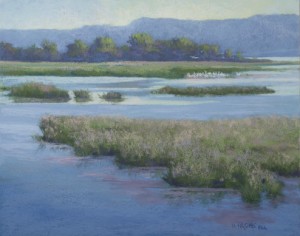When I begin considering an image as a potential painting, one of the first decisions is whether this is a potential “big shape” vs. “center of interest” composition. These are the terms I’ve defined to express the different ways in which I’ve observed well known painters deal with compositions, and I’ve found them to be useful in my own work. (I discuss this in Chapter 6 of my book.) In this post, I’m focusing on a big shape painting, which is what I tend to do most often. In the big shape composition, the impetus generally comes from the strength of the shapes, the flow of values, and the colors that I see or add to a landscape. (In the center of interest composition, the focus is more often on the light hitting a certain area.) Quite often the center of interest is rather minimal or needs to be added. In this painting, for example, I added the grouping of birds in the upper right portion of the painting as a center of interest. However, the painting is really about the shapes, colors, and quality of the light. For me, this decision goes beyond the composition to influence the ways in which I will begin the picture. With a big shape picture, I am more likely to block in the shapes in an underpainting, either using pastel or watercolor. For a center of interest painting, I’m more likely to use a loose-wash watercolor underpainting. For Great River Vista, I did a block in using watercolor. I wanted to keep the colors light and airy, and was afraid that a hard pastel underpainting might overpower the delicacy of the colors.

